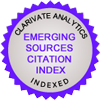A new perspective on public transportation systems investments after the COVID-19 pandemic effect: Bus rapid transit (BRT) for the metropolis, small & medium-scale cities
Fatih YıldızhanGaziantep University, Faculty Of Engineering, Department Of Civil Engineering, Division Of TransportationPublic transport is one of the sectors most affected by the COVID-19 pandemic and consequently public transport ridership has decreased in the ratio of 50%-90% during this period. Some of these passengers are expected not to use public transport even if the pandemic is stable. Due to the high risk of infection in public transportation and the fact that the social distance-face mask rule is not obeyed to a certain extent, new regulations in public transport should be made evident. Bus rapid transit (BRT) is a high-quality public transportation system that has been widely preferred in both metropolis and medium-scale cities in recent years because of its low investment cost and short construction period. In this study, the economic effects of BRT system that is planned with the consideration of social distance according to the requirements of the pandemic were examined in terms of the country's economy and investor/operating institutions. Calculations were performed for the metropolis and small & medium-scale cities as two different types of cities. With the aim to find an urgent solution to the damaged image of public transportation due to the pandemic and the increasing traffic density, the effects of 1, 2 and 3 years of the implementation period on feasibility studies were investigated. In order to minimize the effect of the pandemic, occupancy rates during peak hours were assumed as 70%, which is the value specified for social distance in the literature, and the value of 90% used in feasibility studies. Four different scenarios were created by determining the number of passengers per square meter as 4 and 6. It was determined that the implementation period of BRT in one year could give more profitable results in terms of the country's economy and investor/operating institutions for both types of cities. In terms of the country's economy, it was determined that the scenario of 70% occupancy-4 passengers/m2 could be applied for both cities (the metropolis and small & medium-scale cities). In terms of operating institutions, although the scenario of 70% occupancy-4 passenger/m2 did not give profitable results for both cities, the findings have shown that this scenario could be applied by considering profitability in the country's economy. The results of this investigation show that BRT is a system that could be applied both in the metropolis and small & medium-scale cities with could be a positive influence in minimizing the spread of the pandemic.
Keywords: COVID-19, Social distance, Public transport systems, Bus rapid transit (BRT), Economic evaluationCOVID-19 pandemi etkisinden sonra toplu taşıma sistemleri yatırımlarına yeni bir bakış açısı: Metropol, küçük & orta ölçekli şehirler için metrobüs
Fatih YıldızhanGaziantep Üniversitesi, Mühendislik Fakültesi, İnşaat Mühendisliği Bölümü, Ulaştırma Anabilim DalıCOVID-19 pandemisinden en çok etkilenen sektörlerden biri de toplu taşımadır ve toplu taşıma kullanan yolcu sayısı bu süreçte %50-%90 oranında düşmüştür. Bu yolculardan bir kısmının pandemi stabil olduğunda bile toplu taşıma kullanmaması beklenmektedir. Toplu taşımada bulaş riskinin fazla olması, sosyal mesafe ve maske kuralına belirli oranda uyulmamasından dolayı toplu taşımada yeni düzenlemelerin belirlenmesi gerekmektedir. Metrobüs, düşük yatırım maliyeti ve kısa yapım süresi sayesinde son yıllarda hem metropol hem de orta ölçekli şehirlerde yaygın olarak tercih edilen yüksek kaliteli bir toplu taşıma sistemidir. Bu çalışmada, pandemi koşullarına göre sosyal mesafe dikkate alınarak planlanan metrobüsün ülke ekonomisi ve yatırımcı/işletmeci kurumlar açısından ekonomik etkileri incelenmiştir. Hesaplamalar metropol ve küçük & orta ölçekli şehirlere göre iki ayrı şehir tipi için yapılmıştır. Pandemiden dolayı toplu taşımanın kaybettiği imaja ve artan trafik yoğunluğuna acil çözüm bulunması amacıyla öncelikle 1, 2 ve 3 yıllık yapım süresinin fizibilite çalışmalarına etkisi araştırılmıştır. Pandeminin etkisini en aza indirmek için yoğun saatlerde doluluk oranları, literatürde sosyal mesafe için belirtilen % 70 ve fizibilite etüdlerinde kullanılan %90 olarak alınmıştır. Metrekare başına yolcu sayısı ise 4 ve 6 olarak belirlenerek dört farklı senaryo oluşturulmuştur. Her iki şehir türü için de ülke ekonomisi ve yatırımcı/işletmeci kurumlar açısından metrobüsün bir yılda yapılmasının daha uygulanabilir sonuçlar verebileceği belirlenmiştir. Ülke ekonomisi açısından, % 70 doluluk-4 yolcu/m2 senaryosunun iki şehir için (metropol ve küçük & orta ölçekli şehirler) de uygulanabileceği belirlenmiştir. İşletmeci kurumlar açısından, % 70 doluluk-4 yolcu/m2 senaryosunun her iki şehir için de kârlı sonuçlar vermese de ülke ekonomisindeki kârlılık düşünülerek uygulanabileceği tespit edilmiştir. Bu araştırmanın sonuçları, metrobüsün hem metropollerde hem de küçük & orta ölçekli şehirlerde uygulanabilen ve pandeminin yayılmasını en aza indirmede olumlu etkisi olabilecek bir sistem olduğunu göstermektedir.
Anahtar Kelimeler: COVID-19, Sosyal mesafe, Toplu taşıma sistemleri, Metrobüs, Ekonomik değerlendirmeCorresponding Author: Fatih Yıldızhan, Türkiye
Manuscript Language: English






